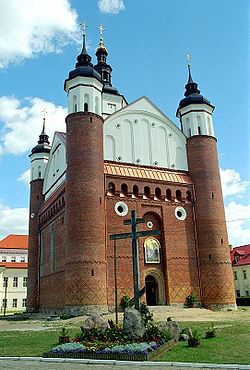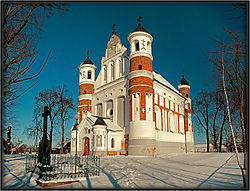Belarusian Gothic
 From Wikipedia - Reading time: 6 min
From Wikipedia - Reading time: 6 min

Belarusian Gothic,[a] also known as Ruthenian Gothic,[1] is the architectural style of ecclesiastical buildings and fortified structures of the 15th and 16th centuries in modern Belarus, Lithuania, eastern Poland and western Ukraine.[2]
Although these buildings have features typical of Gothic architecture such as lofty towers, flying buttresses, pointed arches and vaulted ceilings, they also contain elements not typically considered Gothic by Central and Western European standards.
Terminology
[edit]The term was introduced by Belarusian historian Mikoła Ščakacichin in his work "Essays from the history of Belarusian art"[3] in 1920s. Initially supported by Belarusian historians,[4] in 1960s-80s it gained recognition amongst some of the Russian[5] and Lithuanian historians.[6]
Depending on the area, it can also be referred to as Ukrainian[2] and Lithuanian.[7]
History
[edit]
With the baptism of the Grand Prince Vladimir the Great and the Christianization of the Kievan Rus', the region's architecture became heavily influenced by Byzantine architecture.
During the 13th century and start of 14th century, the Slavic principalities are eventually subjugated by the Grand Duchy of Lithuania, a pagan state which was fighting against the Teutonic Order's expansion. The Grand Duchy became a dominant power in the 14th century, featuring a developed Lithuanian nobility. Lithuanian rulers started building Brick Gothic castles and establishing Catholic churches, which were also constructed in Brick Gothic. Contacts with the Teutonic order and Europe allowed to hire experienced architects.
The Act of Krėva in 1386 caused the Christianization of Lithuania and increased communication in western and southern Europe. Christianization of Lithuania led to more intensive expansion of Western culture and namely, Gothic style into Orthodox lands.
During this period, the Gothic style came to the Slavic regions. In central and southern Europe however, it was already being displaced by Renaissance architecture.
In 1346 the Orthodox Cathedral of the Theotokos, Vilnius[8] in Vilnius, was constructed, before the Lithuanian state had become Catholic. (see history of Roman Catholic Lithuania).
- Examples
-
Cathedral of Ss. Boris and Gleb,[9] Navahrudak (1519–1630), southern façade
-
Cathedral interior (1930 photo)
-
The 16th-century Mir Castle
-
Church of Supraśl Orthodox Monastery, Poland
-
Church in Muravanka
Architecture
[edit]Belarusian Gothic combines Byzantine, Gothic, and Renaissance architecture. Although some buildings have a north-German Brick Gothic design, others are plastered. Window arches are primarily pointed, but blind arcades and Lombard bands have round arches. Most churches have rib vaults, but there are also simple massive trunks such as those in Romanesque and Byzantine architecture. Most were fortified, with a short nave and a small tower at each corner; others have an ordinary, high, Western bell tower.[12]
Comments
[edit]- ^ Belarusian: беларуская готыка, romanized: bełaruskaja hotyka
References
[edit]- ^ Jerzy Lileyko. Sztuka ziem wschodnich Rzeczypospolitej XVI-XVIII w.; ISBN, 8387703389
- ^ a b Православная архитектура ВКЛ начала XVII в. Стиль и традиция.
- ^ Шчакаціхін М. Нарысы з гісторыі беларускага мастацтваю / Репринт. изд. 1928 г. — Мн., 1993. — С. 242—270
- ^ Касьпяровіч М. Беларуская архітэктура. — Віцебск, 1925. — С. 25-30, 52.
- ^ Квитницкая Е.Д. Малоизвестные зальные сооружения Белоруссии конца XV – начала XVI в. В сб. «Архитектурное наследство» № 16. — М., 1967
- ^ Янкявічэне А. С. Самабытныя рысы беларускай готыкі //Помнікі гісторыі і культуры Беларусі. 1974. № 1 (17). — С. 1-21
- ^ История искусства народов СССР: Искусство конца XVII-XVIII веков
- ^ Description of the Cathedral of the Theotokos - in Russian
- ^ www.radzima.org (Belarusian portal on monuments in Belarus, Lithuania and Podlachia) Царква Святых Барыса й Глеба|Навагрудак (description of Boris-and-Gleb-Church in Belarusian)
- ^ Roman Aranazy, Dzieje rezydencji na dawnych kresach Rzeczypospolite (Residences in former districts of the (Polish) Republic today (in Polish), 1993, S. 209, Hniezna
- ^ radzima.org – touristic presentation of Hnezna
- ^ "The Seven Key Characteristics of Gothic Architecture: From the Gargoyle to the Flying Buttress". Exploring Castles.
Sources
[edit]- Nigel Roberts, Belarus, p. 185 (google books)
- Rainer Lindner, Historiker und Herrschaft: Nationsbildung und Geschichtspolitik in Weißrußland im 19. Und 20. Jahrhundert, Verlag Oldenbourg 1999, ISBN 3-486-56455-2, S. 256, II. Nation und Geschichte im Stalinismus → 3. Rivalität der Mythen (Nation-building and policy of history in Belarus in the 19th & 20th centuries) – in German
- Archives of Belarus, Church Architecture
- Беларуская готыка ў пабудове культавых будынкаў XV-XVI стст. – Belarusian Gothic in religious buildings of the 15th and 16th centuries (in Belarusian, very much illustrated) Archived 2020-02-21 at the Wayback Machine
 KSF
KSF









